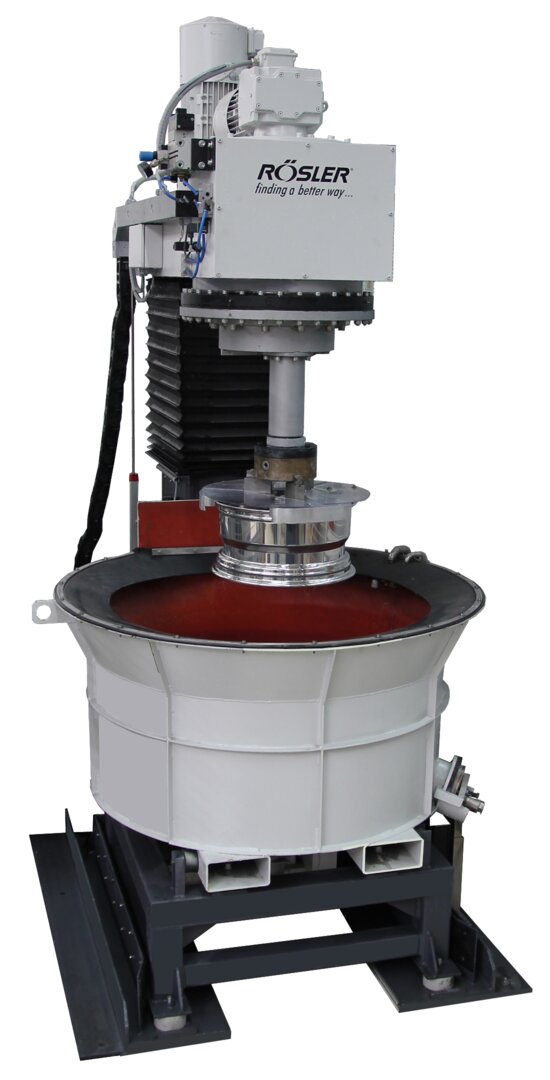
Mass Finishing Machine Settings Series, Part 1 – Improve Machine Function with Proactive and Responsive Observation, Calibration
, sramaker - Back to overview
Even if the finishing media and compound/water are managed perfectly, without a well-functioning machine a mass finishing process is doomed to fail. Focusing on a few essentials will ensure that a mass finishing machine is performing as intended.
From machine settings to preventative maintenance and troubleshooting tips, Rosler has the experience and insight to keep mass finishing machines running efficiently.
The Right Machine Settings
The speed at which a machine is running is critical to the success of a finishing process.
If the machine is running too slow, the finishing results, deburring/edge radiusing, surface grinding, etc., might not be achieved at all or only after excessively long processing times.
If the machine is running too fast, the work pieces may be damaged by scratching, nicking, or bending. Excessive speeds will also cause the media to wear much faster without the benefit of shorter cycle times. Beyond speed, other machine settings must be taken into consideration based on the specific machine type.
Rosler's R 420 EC vibratory tub machine with media
Vibratory
The energy required to move the media and part mix in a rotary, tub, or linear continuous flow vibrator is created by the vibratory motor and imbalance weights. As such, the motor speed, setting of imbalance weights, and the mass of imbalance weights are adjusted to match the processing needs.
Rosler's FKS centrifugal disc machine from above
Centrifugal Disc Finishing
Rotation of the spinner in the bottom of the processing bowl produces energy needed to accelerate the media and parts batch in a centrifugal disc finishing machine. The speed of the drive motor and the ribs on the spinner should be regularly evaluated to ensure effective energy transfer.
Rosler's R6/1000 with automatic loading robot
Drag Finishing
Within a drag finishing machine, the movement of the fixtured parts through the stationary media mass is powered by the rotation of the carousel, work station(s), and, sometimes, individual work station spindles. The speed of each component as well as the angle of the work stations determine the intensity of the process. Immersing the part deeper in the mass increases the processing intensity.
Rosler's R 1-1 TSA plunge finishing machine
Plunge Finishing
In a plunge finishing machine, the fixtured part moves in relation to the static media. The motion is driven by the eccentric spindle rotation and rotational and/or vertical oscillation. The rotational speed of the motor driving the spindle(s) as well as the frequency and amplitude of the oscillation determine the processing intensity. As with drag finishing, immersing the part deeper in the mass increases the processing intensity.
Rosler's surf finishing machine
Surf Finishing
Also referred to as spin finishing, surf finishing machines rely on a rotating processing bowl with the media and a stationary work piece holder to introduce the required energy for the finishing process. The parts are fixtured to the work piece holders on a robot arm or a slowly rotating spindle. Possible points of adjustment and evaluation include the rotational speeds of the processing bowl. The angle of the work piece holder and the immersion depth also affect the processing intensity. A six-axis robot can provide almost infinite degrees of process intensity for different areas of the same part.
Regardless of the machine type, correctly connecting the motor drive is vital. The rotational direction of the motor is one of the main causes for a poorly running process after a machine has been repaired or moved to a new location. Such a small mistake can have disastrous results by completely ruining a mass finishing process.
Preventive Maintenance
As with any other manufacturing operation, preventive maintenance will allow you to achieve consistent, high‐quality results with your mass finishing equipment. Operator manuals usually provide detailed guidelines for properly maintaining your equipment.
Reputable machine producers will provide preventive maintenance checklists with a quick overview of the essential equipment and process aspects. If regularly checked, these steps will ensure that the desired finishing results are consistently achieved without any unnecessary equipment downtimes.
In addition, the checklists provided by Rosler also include valuable pointers for managing the grinding and polishing media levels as well as the compound and water flow rates.
Troubleshooting Tips
Optimal interaction between equipment, media, compound, and water are the key to achieving good mass finishing results. Small changes in the surface condition of the raw work pieces (for example, an oil change in a stamping operation), use of a different compound and/or different media, use of a different water source with harder or softer water, a poorly calibrated compound dosing pump, plugged machine drains, the wrong wiring of a drive motor, the wrong motor speed, incorrectly set imbalance weights, and a number of other factors can drastically impact a mass finishing process.
For situations where the finishing results are no longer what they are supposed to be, machine manufacturers can provide a checklist of troubleshooting tips and suggestions as to what might have gone wrong. Qualified service and process technicians can also provide an assessment of your system.
The Rosler Way
With more than 80 years of experience, Rosler has extensive knowledge in identifying ideal setting configurations as well as developing the machines themselves. Contact us to discuss your machine needs and issues, both proactive and reactive.
The Mass Finishing Settings & Imbalance Weights Series will continue with, “Part 2 – Determine Imbalance Weight Settings for Consistent Results.”
Sign up for enews alerts to follow the Rosler Blog and be notified of new posts!




